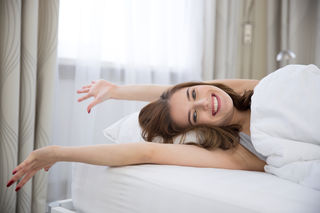Stress
5 Relaxation Techniques for Better Sleep
Expert approaches to draining stress and anxiety so you can power down.
Posted January 1, 2017 Reviewed by Jessica Schrader

We’re coming off a bitterly fought election. We've slogged through the holidays. And now it is a new year. These situations all lead to plenty of stress—and probably a lot of restless sleep—now, and maybe in our future. Instead of white-knuckling it, consider trying my five favorite relaxation practices to help you manage stress and anxiety, and sleep better.
The Relationship Between Anxiety and Sleep
If, like most people, you’ve ever had trouble falling asleep or staying asleep because of stress and worry, you’ve experienced the strong connection between anxiety and insomnia. Stress routinely tops the list of patients' sources of sleep problems.
Anxiety causes racing thoughts, making it difficult to quiet the mind. It can contribute to heightened, intense emotions, including intrusive fear and a sense of being overwhelmed. Stress and anxiety lead to physical tension throughout the body. Under stress, the body releases more of several hormones—including adrenaline, cortisol, and norepinephrine—that boost energy and alertness, raise heart rate and blood pressure, and prime the body for “fight or flight.” Along with other symptoms of anxiety, these hormonally-driven responses to stress all contribute to:
- Difficulty falling asleep.
- Trouble staying asleep throughout the night.
- Waking very early.
- Waking feeling unrested and unrefreshed.
These are the hallmark symptoms of insomnia. Anxiety can contribute to different types of insomnia. Periods of high and intense stress, often resulting from difficult or unexpected life events, can trigger acute insomnia, which comes on suddenly and lasts for a relatively short period of time, from a few days to a few weeks. A tense encounter at work, a fight with a partner, or the death of a loved one are the types of anxiety and stress-producing events that trigger acute insomnia.
Anxiety symptoms, when consistently present, can also bring about chronic insomnia, which may persist on a regular basis for more than a month. Anxiety disorders are often accompanied by insomnia.
Stress and sleep exist in a bidirectional relationship. Just as stress and anxiety trigger insomnia and other sleep problems, lack of sleep increases stress and anxiety. Poor sleep makes us more vulnerable to the symptoms of anxiety, including:
- Irritability and short temper.
- Feelings of being overwhelmed.
- Struggles with motivation.
- Trouble with concentration and memory recall.
- Lack of energy.
- Increased emotional reactivity.
High stress and lack of sleep both contribute to greater risks for mental and physical illness. Stress and insufficient sleep are each independently linked to obesity and weight gain, anxiety and depression, Type 2 diabetes and other metabolic disorders, cardiovascular disease, and cognitive dysfunction.
Managing stress and ensuring a routine of plentiful, high-quality sleep are critical to protecting your health. Relaxation exercises can help you do both. They have been shown highly effective in reducing stress and improving sleep. Low-impact, self-directed, and easily integrated into your daily life, these relaxation strategies can help you get a handle on stress and anxiety during your waking day, and help you de-stress before you go to bed. The truth is, the line between day and night is not so clear. How we behave during the day—including how we manage stress—has a significant effect on how well we sleep at night. Think of your daily, consistent attention to relaxation as a round-the-clock investment in your nightly sleep.
1. Autogenic training
Autogenic training (AT) isn’t particularly well known. That’s a shame, because it is an effective, accessible method for reducing stress and improving sleep. AT uses a series of exercises to focus the mind’s attention to specific physical sensations of the body, in order to relax both mentally and physically. Autogenic training focuses the mind on cultivating sensations of warmth and heaviness in different regions of the body. These exercises use both visual imagery and verbal cues to relax physically as well as to quiet and calm one’s thoughts. The exercises are most effective when practiced regularly, and you can use these techniques to manage stress throughout the day. Incorporating autogenic training into your nightly power-down routine can help you prepare the body and the mind for sleep.
2. Biofeedback
Biofeedback techniques collect information about the body that alert you to stress and allow you to take steps to relax, mentally and physically. Biofeedback works through sensors that track and measure different physical functions, including:
- Breathing
- Heart rate
- Sweating
- Body temperature
- Muscle contraction
- Sleep stages
These physiological processes provide important signals about stress levels. Rapid breathing, sweaty palms, and an uptick in heart rate are common signs of anxiety. Biofeedback, by bringing attention to these physical manifestations of stress and anxiety, gives you the chance to deal with that stress using other relaxation strategies. There is a booming business in providing biofeedback through mobile and wearable devices. Many wearable trackers can deliver information about stress and emotions, as measured through biofeedback. Of course, tracking on its own can’t relax you—but it can make alert you to signs of stress so you can take focused, self-aware steps toward relaxation, whether in the middle of an active day or as you prepare for sleep.
3. Breathing
Deep, slow, self-aware breathing is an ancient and powerful way to clear the body of stress and tension, and a great way to relax as part of a nightly transition to sleep. Deep breathing kicks off a series of physiological changes that aid relaxation, including reducing muscle tension, slowing breathing rate and heart rate, and lowering blood pressure and metabolism.
A breathing practice can be as simple as taking a series of even, slow inhale and exhale breaths as a regular routine during the day or whenever you feel anxious or stressed. There are also a multitude of structured breathing exercises—"4-7-8" breathing is one of my favorites. In a comfortable position, with your eyes open or closed:
- Inhale for four seconds
- Hold your breath for seven seconds
- Exhale slowly, for eight seconds
- Repeat several times
What does the act of deep breathing do for the body and mind to relax and promote healthy sleep? By inhaling deeply and holding your breath, you’re increasing the body’s oxygen level, allowing it to work slightly less hard. A long, slow exhale has a meditative quality to it that is inherently relaxing. That slow exhale is also very similar to the pace of breathing your body adopts as you’re falling asleep. By deep breathing before bedtime, in a way you’re mimicking the breathing patterns of sleep onset, and nudging your body and mind toward its all-important period of rest.
4. Guided imagery
Think about tasting a tart or sour food—sucking on lemon or a lime, or swallowing a teaspoon of vinegar. Really imagine the experience—the smell, the taste on your tongue, the sensation as the food hits your throat. Now, what just happened? You likely had a physical reaction to this fantasy. Maybe your lips puckered or your mouth watered. That is the power of imagination, and of guided imagery. When we imagine something, our bodies respond as though they were actually experiencing that moment.
Guided imagery is a mind-body technique that can reduce stress and promote sleep. Guided imagery exercises engage all the senses in a focused period of imagination. This powerful mind-body tool helps to connect the conscious and unconscious mind, and helps the mind direct the body toward positive, desirable responses. Guided imagery can be tailored and targeted to different goals, including to relieve physical and mental stress, to reduce anxiety, and to prepare for and bring about sleep. It is another terrific component of a nightly pre-bed routine. Spending a few minutes engaged in a soothing, restful guided image journey—such as imagining floating peacefully in a calm ocean, being rocked by gentle waves and covered by a warm breeze—can help you gently separate from the stresses of the day and prepare the mind and body to sleep.
There are several different levels and forms of guided imagery, ranging from visualizations to more organized and targeted imaginative scripts and storytelling. It’s possible to learn guided imagery on your own. It can also be valuable to seek the assistance of a therapist or practitioner in developing a guided imagery practice.
5. Progressive relaxation
This mind-body relaxation technique is a simple, striking way to become familiar with your body and the places where you hold stress and tension. Progressive relaxation involves working, one at a time, with different areas and muscle groups of the body, first tensing and relaxing them. This cultivates an awareness of what both tension and relaxation feel like in your body. With that awareness, you become better prepared to address that physical tension—and any mental or emotional stress that accompanies it.
Used as part of a nightly power-down routine, progressive relaxation can help you release physical and mental tension that, left unaddressed, can interfere with sleep. A typical progressive relaxation routine starts at the lowest point of the body—the feet—and works gradually up to the top of the head, tensing and relaxing every area of the body along the way.
The Broad Benefits of Relaxation
Scientific studies show the benefits of these relaxation techniques in managing stress and promoting sound and restful sleep. Controlling stress and getting sufficient high-quality sleep are two important components of health, so by employing relaxation techniques to help in these areas, you’re making an investment in your fundamental well-being.
These same techniques are also used to help a range of other health conditions. On their own, and more often in conjunction with other therapies, these five practices may help:
- Reduce chronic and intermittent pain
- Limit daytime fatigue
- Ease nausea
- Improve cardiovascular function, including lowering blood pressure
- Treat and control symptoms of mood disorders, including depression, anxiety, and PTSD
- Quit smoking
These techniques are also used in the treatment of cancer and other serious illnesses to help patients better cope with symptoms and treatment. There is preliminary, emerging evidence that meditation and relaxation practices may contribute to better cancer outcomes. Studies also indicate that relaxation practices may have a positive effect on immune function and nervous system activity.
The broad potential benefits of relaxation practices stand to go way beyond helping you manage your way through the holidays, or navigate post-election conversations with co-workers and friends. Integrating relaxation exercises into your daily life can significantly improve your sleep, lower your levels of ongoing stress and anxiety—and help you better cope with the acute spikes in stress we all encounter in life. They can contribute to whole-body health and wellness, through every day and every season.
Sweet Dreams,
Michael J. Breus, Ph.D.
The Sleep Doctor™
Follow me on Facebook.




